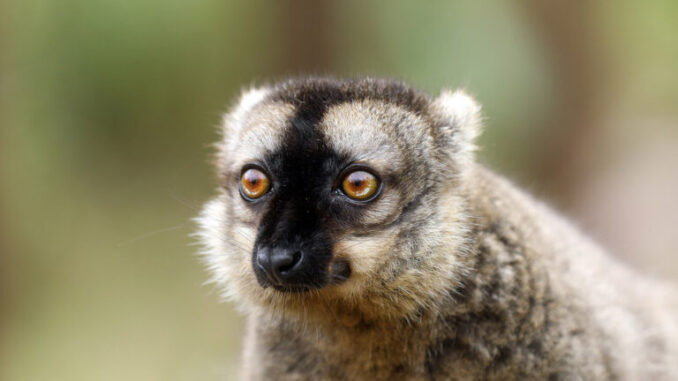
[ad_1]
In May, authorities in southern Thailand arrested six people for illegally transporting 48 lemurs and more than 1,200 critically endangered tortoises, all of which had reportedly been obtained from the wild in Madagascar.
The seizure is the latest in a string of illegal wildlife trade busts in Thailand. Red pandas (Ailurus fulgens), monitor lizards, snakes and parrots have been uncovered in similar incidents in the country in recent months, for instance. However, the recent seizure of so many critically endangered animals from Madagascar has alarmed experts, who say the latest bust underscores the global reach of wildlife trafficking networks using Thailand as a transshipment hub for illegally sourced wild animals and plants.
“The quantity seized points strongly towards the existence of an organized network of traffickers, and the use of the sea route to move the animals out of the national territory,” Simon Rafanomezantsoa, lead of WWF Madagascar’s antitrafficking team, said in a statement.
Authorities discovered the animals caged and boxed in cramped conditions in six pickup trucks in Chumphon province on May 1. The authorities were acting on intelligence from an international investigation operating in the country to clamp down on cross-border organized wildlife crime.
In total, authorities uncovered 1,234 tortoises: 357 radiated tortoises (Astrochelys radiata) and 877 spider tortoises (Pyxis arachnoides), both of which are listed as critically endangered on the IUCN Red List. Among the lemurs were 16 ring-tailed lemurs (Lemur catta) and 32 common brown lemurs (Eulemur fulvus), listed respectively as endangered and vulnerable on the IUCN Red List.
The animals had been smuggled by sea into Thailand’s Satun province via Sumatra in Indonesia, according to Wacharin Pusit, a commander from the Royal Thai Police. Pusit also told local media the shipment was likely destined for markets in Hong Kong, South Korea and Taiwan. Following the initial seizure, officers found a further 179 radiated tortoises, 30 primates and three juvenile crocodiles at a farm connected to the suspects, where one additional arrest was made.

Transnational criminal networks
The seizure was part of a joint transnational investigation between Thai law enforcement agencies and international partners, including the U.S. Fish and Wildlife Service, the United Nations Office on Drugs and Crime (UNODC), and the Wildlife Justice Commission. In particular, the investigation aims to dismantle global wildlife trafficking networks spanning Asia, Africa and South America, including the exposure of corrupt officials.
According to the Wildlife Justice Commission, this particular trafficking network specializes in the illegal trade of small mammals, turtles and tortoises, and other reptiles for the international live pet trade. The financial loss and arrests associated with this latest seizure are expected to hamper the network’s wider activities, according to the investigation partners.
“We commend the unwavering dedication and collaborative spirit demonstrated by all involved in dismantling this illegal pet trade network,” Olivia Swaak-Goldman, executive director of the Wildlife Justice Commission, said in a statement following the bust. The seizure in Thailand “sends a clear message that wildlife trafficking will not be tolerated, and perpetrators will be brought to justice,” she added.

New target species as supplies dwindle
All of the confiscated Madagascan species are listed under Appendix I of the Convention on International Trade in Endangered Species (CITES), the international treaty to ensure commercial wildlife trade doesn’t lead to species extinctions. This effectively means their trade is permitted only when documentation and permits indicate they were not taken from the wild.
Some 98% of lemur species are threatened with extinction in the next 20 years, according to the IUCN, mainly due to deforestation and hunting pressure. Meanwhile, populations of both radiated and spider tortoises have declined catastrophically in recent years due to poaching for the illegal wildlife trade. As one of the most trafficked tortoises in the world, radiated tortoise numbers have plummeted 80% over just the past two decades.
Rick Hudson, president emeritus of the Turtle Survival Alliance (TSA), an organization that operates a network of tortoise rescue centers in Madagascar, said the abundance of spider tortoises in the recent seizure indicates that poachers have begun targeting the smaller-bodied species in the absence of young radiated tortoises, which have been hunted to brink of extinction in the wild.
“Small baseball-sized tortoises are preferred by traffickers because they are easier to conceal and pack in suitcases or boxes; this size class of radiated [tortoise] has largely disappeared from the landscape,” Hudson told Mongabay, adding that he fears the same fate awaits spider tortoises. “We know of sites that were abundant with spider tortoises 20 years ago are now devoid of tortoises; this can happen rapidly.”

Illicit web fuels pet trade
Madagascar authorities have so far arrested 18 people in connection with the seizure.
“We have proof of the actions of these individuals, photos, proof of their connections with contacts in Thailand,” Ernest Lainkana Zafivanona, director-general of Madagascar’s customs authority, told local media in June, adding that officials are actively pursuing multiple other suspects as the transnational investigation progresses.
Since lemurs and both species of tortoise are strictly protected under Madagascar wildlife law — which prohibits their possession, purchase, transportation or sale — the suspects each face penalties of up to 10 years’ imprisonment and fines of up to approximately $44,500. However, multiple sources told Mongabay that despite the steep penalties embedded within the law, in reality, the prosecution and punishments levied against wildlife crimes are typically inadequate to deter poaching in Madagascar.
Zafivanona said the international incident highlights the vulnerability of Madagascar’s vast coastline and protected areas to unscrupulous trade, particularly along the remote southern coast that skirts the critically endangered tortoise species’ natural range.
“There are still gaps in coastal surveillance. Improvements are necessary in the control system of our 5,000 kilometers [3,000 miles] of coastline,” he said.

Max Andonirina Fontaine, Madagascar’s environment minister, told Mongabay that despite efforts to strengthen the country’s wildlife laws, effective enforcement along the country’s extensive coastline is ultimately stymied by a lack of resources. This is compounded by a recent surge in international demand for endemic species and the “well-organized” nature of the trafficking networks, he added.
“As these bad networks are organized, we need also to be organized and strengthen collaboration,” Fontaine said, pointing to the recent founding of an illegal wildlife trade task force between Madagascar, Thailand, Malaysia, Indonesia and Taiwan, as well as reinforcement of national security measures, such as monitoring of roads, community awareness campaigns, and scaling up of drone-based surveillance in protected areas.
In addition to a lack of resources for law enforcement, sources told Mongabay that systemic corruption at multiple levels in Madagascar’s public service and judicial system can hamper efforts to control trade. A 2023 investigation by Transparency International Initiative Madagascar, for instance, identified bribery, abuse of power, and unscrupulous customs procedures at local ports as among the factors facilitating tortoise trafficking in the Androy and Atsimo Andrefana regions in the heart of the natural range of radiated tortoises.
The slew of recent arrests and efforts by officials in Madagascar to collaborate on the Thailand-based trafficking investigation could be a positive sign that things are beginning to change. The recent commitment to crack down on the transnational network “underscores Madagascar’s serious commitment to combating wildlife crime and demonstrates their dedication to bringing all perpetrators to justice,” Swaak-Goldman of the Wildlife Justice Commission, told Mongabay.

Confiscated animals ‘especially problematic’
With investigations into the perpetrators underway, Fontaine visited Bangkok in early June to negotiate with Thai authorities for the repatriation of the confiscated lemurs and tortoises. He told Mongabay the animals are due to return to Madagascar by the end of July, where they will be quarantined and cared for in rehabilitation centers and eventually, where possible, returned to the wild.
However, specialists say returning confiscated animals to the wild is fraught with logistical challenges and exorbitant financial costs. The paucity of rescue centers equipped to receive such vast numbers of animals is one hurdle. Another is the risk of disease transmission.
“The Bangkok tortoises are especially problematic in terms of repatriation because they have left Madagascar and been moved through Indonesia and then co-mingled with other tortoises, exposing them to potential pathogens,” said Hudson of the Turtle Survival Alliance, which is the main organization operating in Madagascar with the capacity to care for confiscated tortoises and prepare them for release back into the wild.
Hudson said that ideally the TSA would be able to screen the confiscated tortoises in Thailand for diseases prior to their return to the African island. The screened tortoises would then need to be housed at a quarantine facility separate from other tortoise rescue centers in Madagascar. However, no such facility exists.
Indeed, tortoise rescue centers are already bursting at the seams. Facilities managed by the TSA in southern Madagascar house more than 24,000 tortoises, most of which came from two enormous domestic seizures in 2018. Moreover, in addition to the load of tortoises now held in Bangkok, the TSA is under continuous pressure to accept hundreds of confiscated Madagascan tortoises held in other territories, such as Tanzania, Mozambique and Hong Kong.
Given the limited government resources for wildlife rescue in Madagascar, the TSA bears the burden of costs associated with repatriation of confiscated animals, which range from veterinary costs to disease screening and genetic testing to ensure animals are fit for release back into the wild, to the food and housing infrastructure. In short, it’s an enormous task, Hudson said.
“The pressure to ‘bring them home’ is intense but no funds are forthcoming to assist that effort,” he said. “It will not be cheap.”

This article by Carolyn Cowan was first published by Mongabay.com on 28 June 2024. Lead Image: A common brown lemur, one of the four threatened and endemic species from Madagascar confiscated in the May 2024 seizure in Thailand. Image by Rhett A. Butler / Mongabay.
What you can do
Help to save wildlife by donating as little as $1 – It only takes a minute.
[ad_2]
Source link

Leave a Reply